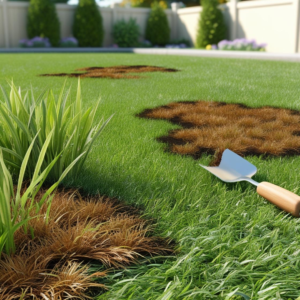Is Your Lawn Looking a Little Sparse? Here’s How to Give It the Full-Body Treatment

A lush, green lawn can be the crowning jewel of any yard. It adds curb appeal, creates a comfortable space for outdoor activities, and provides a visual sense of order and tranquility. However, maintaining that picture-perfect lawn can sometimes feel like an uphill battle, especially when patches of bare soil start to peek through, leaving your yard looking more “sparse” than “lush.” If your lawn has been looking a little underwhelming, it’s time to give it the full-body treatment and bring it back to life.
In this article, we’ll walk you through a step-by-step process for reviving your lawn, addressing everything from soil health and proper seeding techniques to watering practices and fertilization. With some time, effort, and the right approach, you can transform your patchy lawn into a thick, vibrant carpet of greenery.
Why Does Your Lawn Look Sparse?
Before we dive into the solutions, it’s important to understand why your lawn might be looking thin or uneven. There are a number of potential causes, some of which can be remedied fairly easily, while others may require more attention. Here are some common reasons your lawn could be sparse:
- Poor Soil Quality: Compacted soil, poor drainage, or nutrient deficiencies can prevent grass from growing properly.
- Over or Underwatering: Inconsistent watering practices can stress grass, causing it to become weak or patchy.
- Pest or Disease Problems: Insects, fungi, or diseases can damage grass roots, leading to bare patches.
- Improper Mowing: Cutting grass too short or using dull blades can damage the grass and prevent it from growing uniformly.
- Heavy Foot Traffic: Constant use of the lawn (by kids, pets, or even just walking through the yard regularly) can lead to worn areas.
Now that you have a better understanding of the possible causes, let’s explore how you can address these issues give your lawn the care it deserves.

Step 1: Assess the Health of Your Soil
Healthy soil is the foundation of a thriving lawn. If your soil isn’t in good condition, your grass will struggle to grow, no matter how much you water or fertilize it. Therefore, the first step in giving your lawn the full-body treatment is to assess its health.
Conduct a Soil Test
A soil test will tell you what nutrients your soil may be lacking and whether its pH level is optimal for grass growth. Most grasses prefer a slightly acidic to neutral pH (around 6.0 to 7.0), and a soil test will give you a precise measurement of your soil’s pH. You can purchase a soil test kit at your local garden center or send a sample to a lab for a more detailed analysis.
Check for Soil Compaction
Soil compaction occurs when the ground becomes so compacted that water and air can’t penetrate it properly. This often results in sparse patches or areas where grass is struggling to grow. You can check for soil compaction by attempting to stick a garden fork or shovel into the ground. If it’s difficult to penetrate, the soil may be compacted.
How to Fix Soil Compaction
If you have compacted soil, aerating your lawn will be a game-changer. Aeration involves creating small holes in the soil, allowing air, water, and nutrients to reach the grassroots more effectively. This can be done using a lawn aerator, which you can rent from a local hardware store or hire a professional to do for you.
For those with smaller lawns, a manual aerator (which looks like a fork or spike) can work just as well. Aerate your lawn in the spring or fall when the grass is actively growing for the best results.
 Step 2: Choose the Right Grass Seed
Step 2: Choose the Right Grass Seed
Once your soil is in optimal condition, it’s time to focus on the grass itself. The type of grass you plant will depend on your climate, the amount of sun your lawn receives, and the overall aesthetic you’re going for. There are cool-season grasses (e.g., Kentucky bluegrass, fescue) and warm-season grasses (e.g., Bermuda, zoysia), each with specific needs and advantages.
Cool-Season vs. Warm-Season Grasses
- Cool-Season Grasses: These grasses thrive in cooler climates and grow best in the spring and fall. They’re ideal for regions with harsh winters or mild summers. Examples include Kentucky bluegrass, ryegrass, and fescue.
- Warm-Season Grasses: These grasses do best in warmer climates and grow most vigorously during the summer. They go dormant in cooler weather. Examples include Bermuda grass, zoysia, and St. Augustine.
If you live in a region where both warm and cool-season grasses could potentially grow, it’s important to select the type that best matches your specific lawn care needs.
Over-seeding for a Fuller Lawn
If your lawn has thin or bare spots, over-seeding is a great way to thicken it up. Over-seeding involves spreading a new layer of grass seed over your existing lawn. It’s particularly effective if you want to improve grass density or introduce a more resilient variety.
For best results, over-seed in the early fall (for cool-season grasses) or late spring (for warm-season grasses). Ensure your grass seed is spread evenly by using a broadcast spreader.

Step 3: Proper Watering Techniques
Water is essential for grass growth, but it’s easy to either overwater or underwater your lawn. Both extremes can contribute to a sparse lawn.
How Much Water Does Your Lawn Need?
In general, lawns need about 1 to 1.5 inches of water per week. However, this can vary depending on weather conditions, soil type, and grass variety. Deep, infrequent watering is better than frequent shallow watering because it encourages grass roots to grow deep into the soil.
If you’re unsure how much water your lawn is receiving, you can place a few empty cans (like tuna cans) around your lawn and run your sprinkler. Once the cans have collected about 1 to 1.5 inches of water, you know you’ve hit the right mark.
Best Time to Water
Water your lawn early in the morning to reduce evaporation and ensure the grass has time to dry out before evening. Watering at night can lead to mold or fungal issues, as the grass stays wet for longer periods.
Avoid Overwatering
While grass needs water to thrive, too much water can suffocate the roots and encourage fungal diseases. Make sure your lawn’s soil drains well and avoid standing water in low areas. A well-aerated lawn will allow water to penetrate deep into the soil without pooling on the surface.

Step 4: Fertilization
for Lawn Health
Grass, like all plants, requires nutrients to grow strong and healthy. Fertilizing your lawn properly can help it thrive and outcompete weeds, which often crop up in sparse areas.
Understand Your Lawn’s Nutrient Needs
A balanced fertilizer with a ratio of nitrogen (N), phosphorus (P), and potassium (K) is essential for healthy grass. Nitrogen promotes leafy, green growth, phosphorus encourages strong root development, and potassium helps the grass withstand stress.
When to Fertilize
The best times to fertilize your lawn depend on the type of grass you have:
- Cool-Season Grasses: Fertilize in early spring and fall, when these grasses are growing most actively.
- Warm-Season Grasses: Fertilize in late spring and summer, when the grass is in its peak growing season.
Apply fertilizer after mowing, and be sure to follow the manufacturer’s instructions to avoid over-application, which can burn your grass.
 Step 5: Mowing Tips for a Healthier Lawn
Step 5: Mowing Tips for a Healthier Lawn
Mowing is an important part of lawn care, but it’s easy to make mistakes that could lead to a sparse lawn. Cutting grass too short (also known as “scalping”) can stress the plants and leave them vulnerable to diseases and pests.
How to Mow for Optimal Lawn Health
- Set the Right Mower Height: Keep your grass about 2.5 to 3 inches tall. This will encourage deeper root growth and help the grass retain moisture better.
- Don’t Cut Too Much at Once: Never remove more than one-third of the grass height in a single mowing. If your grass is too tall, mow it gradually over a few days.
- Use a Sharp Blade: A dull blade can tear the grass, causing it to turn brown at the edges. Sharpen your mower blades regularly to ensure a clean cut.
Mulch Your Clippings
Instead of bagging your grass clippings, consider mulching them. Grass clippings contain valuable nutrients that can be returned to the soil as organic matter, helping to improve lawn health.
Step 6: Weed Control
Weeds thrive in areas where the grass is sparse, so controlling them is an essential part of creating a fuller lawn. Weeds steal resources like water, nutrients, and sunlight, further stressing your grass.
How to Manage Weeds
- Pre-Emergent Herbicides: These can prevent weed seeds from germinating. Apply them in early spring or fall, depending on your region and the types of weeds you’re trying to control.
- Spot-Treating Existing Weeds: For weeds that have already taken root, use a post-emergent herbicide or manually remove them. Be sure to follow the label instructions carefully to avoid damaging your grass.
- Maintain Lawn Density: A thick lawn is the best defense against weeds. If your grass is dense and healthy, it will naturally crowd out unwanted weeds.
Conclusion: A Full-Body Lawn Makeover
With a little effort and the right care, you can transform your sparse lawn into a thick, lush expanse of greenery. By assessing your soil, selecting the right grass variety, following proper watering and mowing techniques, and providing your lawn with the nutrients it needs, you’ll be well on your way to achieving a healthy, full-bodied lawn.
It may take some time for the results to become apparent, but with patience and consistency, you’ll be rewarded with a lawn that not only looks great but is also resilient and long-lasting. So get ready to give your lawn the full-body treatment—your yard will thank you!
